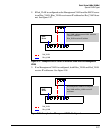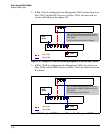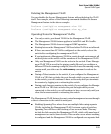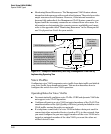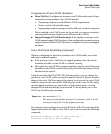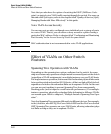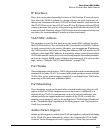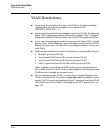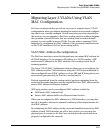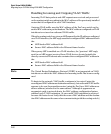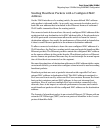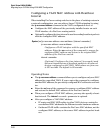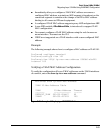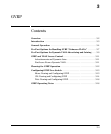
Static Virtual LANs (VLANs)
Migrating Layer 3 VLANs Using VLAN MAC Configuration
Migrating Layer 3 VLANs Using VLAN
MAC Configuration
ProCurve routing switches provide an easy way to maintain Layer 3 VLAN
configurations when you migrate distribution routers in a network configura-
tion that is not centrally managed. By following the procedure described in
this section, you can upgrade to ProCurve routing switches without stopping
the operation of attached hosts that use existing routers as their default
gateway to route traffic between VLANs. You can achieve seamless VLAN
migration by configuring the MAC address of the previously installed router
on the VLAN interfaces of a ProCurve routing switch.
VLAN MAC Address Reconfiguration
The ProCurve switches covered by this guide use one unique MAC address for
all VLAN interfaces. If you assign an IP address to a VLAN interface, ARP
resolves the IP address to the MAC address of the routing switch for all
incoming packets.
The Layer 3 VLAN MAC Configuration feature allows you to reconfigure the
MAC address used for VLAN interfaces using the CLI. Packets addressed to
the reconfigured Layer 3 MAC address, such as ARP and IP data packets, are
received and processed by the ProCurve routing switch.
Packets transmitted from the routing switch (packets originating from the
router and forwarded packets) use the original ProCurve MAC address as the
source MAC address in Ethernet headers.
ARP reply packets use the reconfigured MAC address in both the:
■ ARP Sender MAC address field.
■ Source MAC address field in the Ethernet frame header
When you reconfigure the MAC address on a VLAN interface, you may also
specify a keepalive timeout to transmit heartbeat packets that advertise the
new MAC address.
By configuring the MAC address of the previously installed router as the MAC
address of each VLAN interface on a ProCurve switch, you can swap the
physical port of a router to the ProCurve switch after the switch has been
properly configured in the network.
2-65



